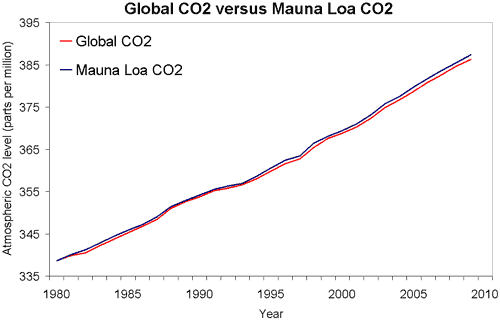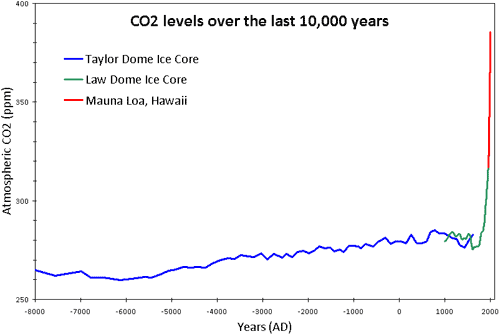- Oct 12, 2009
- 58,613
- 10,629
- 2,030
I could use one of those glaciers too. The solar flares this summer are supposed to fry me.
Follow along with the video below to see how to install our site as a web app on your home screen.
Note: This feature may not be available in some browsers.
I took the source put forth by konradv and made my discovery that it was from Mauna Loa, HI. Then he suggested that glaciers were the source of the data. You jumped in RT and agreed with konradv hurling insults about IQ to boot. Now you're left holding the bag with glaciers in Hawaii. I asked for the scientific process used to determine the 2011 CO2 levels in glaciers found in Hawaii. So far, all I got are your opinions. That and a good laugh.No, you're the idiot who's too stupid to understand what is being said.You're the dumbass trying to pass off Mauna Loa data as glacial.I thought you had a brain. All sorts of things have to be done to get valid data. Using the word 'manipulated' tells us nothing we didn't already know, except that you'll do anything to try and put a bad face on it. Wassamatta, your facts and logic so weak, that's all ya got?!?!I thought they melted. If they did take samples, the data has to be manipulated to compensate for CO2 exchange and other factors.Who was taking acid samples 21000 years ago?Correct, but logic has never been on the side of the skeptics! They ignore the well documented properties of CO2 and that its concentration is about 35% above historical averages. That's TWO STRIKES right there, one for the science and one for logic.
Please cite the two sets of numbers you claim are 35% above historical averages.
Historical average: ~290 ppm. Present average: ~390 ppm.
Trends in Carbon Dioxide
Thank you for the source. This is from Mauna Loa, HI for the period 1959 to the present. Hardly historical in a geologic sense. Also volcanic activity is going to influence those number quite a bit during your period cited. See, this is the type of unscientific cherry picking/manipulation that causes people like me to be a skeptic.
...in ppm?
glaciers
I took the source put forth by konradv and made my discovery that it was from Mauna Loa, HI. Then he suggested that glaciers were the source of the data. You jumped in RT and agreed with konradv hurling insults about IQ to boot. Now you're left holding the bag with glaciers in Hawaii. I asked for the scientific process used to determine the 2011 CO2 levels in glaciers found in Hawaii. So far, all I got are your opinions. That and a good laugh.No, you're the idiot who's too stupid to understand what is being said.
LOLOLOLOLOLOLOLOLOLOLOLOL......this is a great example of the reasons I call you a retard. Thanks for demonstrating it again
Nobody said that the Mauna Loa data comes from glaciers, you pathetic idiot, as the above exchanges demonstrate.
After asking about CO2 level measurements, you, being so completely ignorant about science and very retarded to boot, asked how scientists could possibly determine the levels of acidity in the oceans 21000 years ago (a completely different issue from measuring CO2 levels in the atmosphere now) and you were told that info comes from glaciers. In your stupidity, you forgot what you had just asked, you misunderstood and you went off on a nutcase trip about glaciers in Hawaii being used to measure current CO2 levels. You're too stupid to keep your own questions separate in your own little deranged mind.
And BTW, contrary to your ignorant assumptions, "volcanic activity" does not significantly affect the CO2 readings from Mauna Loa.
Where did konradv's data come from RT? Answer: Mauna Loa.
So...if you're going to compare that to 21000 years ago, you have to have data that old from Mauna Loa.
Apparently, you think that comes from volcaneos. Dance around all you want. It is what it is. I'll ask again. Where is your data from Mauna Loa 21000 years ago?
BTW, 1959 to the present isn't 200 years either, but you have enough problems.


Where did konradv's data come from RT? Answer: Mauna Loa.
So...if you're going to compare that to 21000 years ago, you have to have data that old from Mauna Loa.
Apparently, you think that comes from volcaneos. Dance around all you want. It is what it is. I'll ask again. Where is your data from Mauna Loa 21000 years ago?
BTW, 1959 to the present isn't 200 years either, but you have enough problems.
All of your posts are based on you being very ignorant and pretty stupid.
The current data on CO2 levels is being measured by hundreds of stations scattered across 66 countries, not just the station on Mauna Loa, and they all report the same rising trend.
Ancient CO2 levels are measured using an entirely different method involving analysis of the gas bubbles in different levels of ice in drill cores removed from glaciers. The fact that you don't (or, more likely, can't) understand how science is able to determine information like that only reflects your ignorance, not any inability of the scientists to figure it out.
The fact that you say so many idiotically meaningless things about subjects you're so obviously totally ignorant about, just reflects your extreme stupidity and general mental incompetence.
How reliable are CO2 measurements?
(excerpts)
Mauna Loa is often used as an example of rising carbon dioxide levels because its the longest, continuous series of directly measured atmospheric CO2. The reason why it's acceptable to use Mauna Loa as a proxy for global CO2 levels is because CO2 mixes well throughout the atmosphere. Consequently, the trend in Mauna Loa CO2 (1.64 ppm per year) is statistically indistinguishable from the trend in global CO2 levels (1.66 ppm per year). If global CO2 was used in Figure 1 above, the result "hockey stick" shape would be identical.

Figure 2: Global atmospheric CO2 (NOAA) versus Mauna Loa CO2 (NOAA).
The following graph shows atmospheric CO2 levels over the last 10,000 years. It includes ice core data for CO2 levels before 1950. For values after 1950, direct measurements from Mauna Loa, Hawaii were used.

Figure 1: CO2 levels (parts per million) over the past 10,000 years. Blue line from Taylor Dome ice cores (NOAA). Green line from Law Dome ice core (CDIAC). Red line from direct measurements at Mauna Loa, Hawaii (NOAA).
I took the source put forth by konradv and made my discovery that it was from Mauna Loa, HI. Then he suggested that glaciers were the source of the data. You jumped in RT and agreed with konradv hurling insults about IQ to boot. Now you're left holding the bag with glaciers in Hawaii. I asked for the scientific process used to determine the 2011 CO2 levels in glaciers found in Hawaii. So far, all I got are your opinions. That and a good laugh.No, you're the idiot who's too stupid to understand what is being said.
LOLOLOLOLOLOLOLOLOLOLOLOL......this is a great example of the reasons I call you a retard. Thanks for demonstrating it again
Nobody said that the Mauna Loa data comes from glaciers, you pathetic idiot, as the above exchanges demonstrate.
After asking about CO2 level measurements, you, being so completely ignorant about science and very retarded to boot, asked how scientists could possibly determine the levels of acidity in the oceans 21000 years ago (a completely different issue from measuring CO2 levels in the atmosphere now) and you were told that info comes from glaciers. In your stupidity, you forgot what you had just asked, you misunderstood and you went off on a nutcase trip about glaciers in Hawaii being used to measure current CO2 levels. You're too stupid to keep your own questions separate in your own little deranged mind.
And BTW, contrary to your ignorant assumptions, "volcanic activity" does not significantly affect the CO2 readings from Mauna Loa.
 Someone needs to do better in reading comprehension. I never mentioned Mauna Loa and never suggested it had glaciers.
Someone needs to do better in reading comprehension. I never mentioned Mauna Loa and never suggested it had glaciers. 
Could you help out your buddy?
Please explain how glaciers show the acidity of the ocean 21000 years ago.
Thanks in advance.
CO2 mixes well in the ATMOSPHERE. Of course it doesn't mix equally in ice. Rates of freezing and thawing, differing composition of and percentages of other chemicals exist, some of which modify CO2.
Interesting that the article goes on and shows a map of differing CO2 levels around the world. It also mentions the stations for gathering the information are in industrial nations. You have a skewed sampling base. It talks about annualized CO2 figures being stable, but of course, ice doesn't form over a year's time, but within hours or minutes at an ice cap. Your data is flawed and comes back to the hockey stick. Pretty funny.
Note: I was able to write this without needing to debase the opponent. Your nervousness is evident when resorting to such childish retorts.
Could you help out your buddy?
Please explain how glaciers show the acidity of the ocean 21000 years ago.
Thanks in advance.
By examining the gas composition of trapped bubbles of ancient atmosphere.
CO2 mixes well in the ATMOSPHERE. Of course it doesn't mix equally in ice. Rates of freezing and thawing, differing composition of and percentages of other chemicals exist, some of which modify CO2.
Interesting that the article goes on and shows a map of differing CO2 levels around the world. It also mentions the stations for gathering the information are in industrial nations. You have a skewed sampling base. It talks about annualized CO2 figures being stable, but of course, ice doesn't form over a year's time, but within hours or minutes at an ice cap. Your data is flawed and comes back to the hockey stick. Pretty funny.
Note: I was able to write this without needing to debase the opponent. Your nervousness is evident when resorting to such childish retorts.
You are a scientist with impeccable bona fides? Otherwise link to a source that is trusted.
At present, your post is just yap-yap. Unverified and probably pulled out of your ass.



Could you help out your buddy?
Please explain how glaciers show the acidity of the ocean 21000 years ago.
Thanks in advance.
By examining the gas composition of trapped bubbles of ancient atmosphere.
Please explain how gas bubbles show us the acidity of the ocean.
I took the source put forth by konradv and made my discovery that it was from Mauna Loa, HI. Then he suggested that glaciers were the source of the data. You jumped in RT and agreed with konradv hurling insults about IQ to boot. Now you're left holding the bag with glaciers in Hawaii. I asked for the scientific process used to determine the 2011 CO2 levels in glaciers found in Hawaii. So far, all I got are your opinions. That and a good laugh.
LOLOLOLOLOLOLOLOLOLOLOLOL......this is a great example of the reasons I call you a retard. Thanks for demonstrating it again
Nobody said that the Mauna Loa data comes from glaciers, you pathetic idiot, as the above exchanges demonstrate.
After asking about CO2 level measurements, you, being so completely ignorant about science and very retarded to boot, asked how scientists could possibly determine the levels of acidity in the oceans 21000 years ago (a completely different issue from measuring CO2 levels in the atmosphere now) and you were told that info comes from glaciers. In your stupidity, you forgot what you had just asked, you misunderstood and you went off on a nutcase trip about glaciers in Hawaii being used to measure current CO2 levels. You're too stupid to keep your own questions separate in your own little deranged mind.
And BTW, contrary to your ignorant assumptions, "volcanic activity" does not significantly affect the CO2 readings from Mauna Loa.
Someone needs to do better in reading comprehension. I never mentioned Mauna Loa and never suggested it had glaciers.

CO2 mixes well in the ATMOSPHERE. Of course it doesn't mix equally in ice. Rates of freezing and thawing, differing composition of and percentages of other chemicals exist, some of which modify CO2.
Interesting that the article goes on and shows a map of differing CO2 levels around the world. It also mentions the stations for gathering the information are in industrial nations. You have a skewed sampling base. It talks about annualized CO2 figures being stable, but of course, ice doesn't form over a year's time, but within hours or minutes at an ice cap. Your data is flawed and comes back to the hockey stick. Pretty funny.
Note: I was able to write this without needing to debase the opponent. Your nervousness is evident when resorting to such childish retorts.
You are a scientist with impeccable bona fides? Otherwise link to a source that is trusted.
At present, your post is just yap-yap. Unverified and probably pulled out of your ass.
By examining the gas composition of trapped bubbles of ancient atmosphere.
Please explain how gas bubbles show us the acidity of the ocean.
Do we have to do everything for you? If you've read the threads on this board, you'd know how? If you haven't, do some research and get up to speed. Who has time to keep repeating basic principles over and over again?



